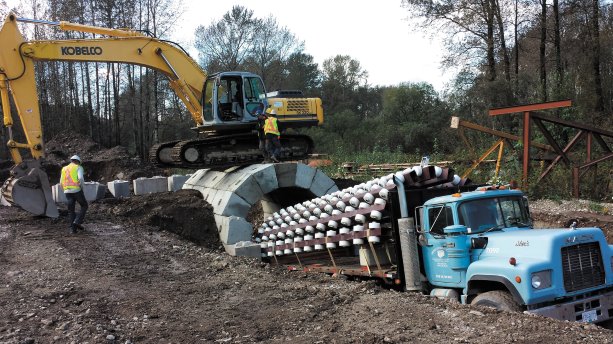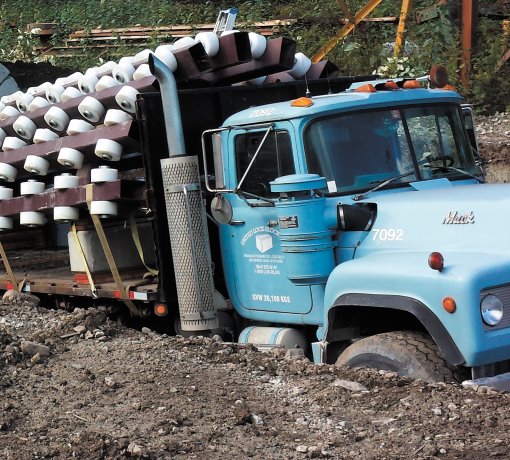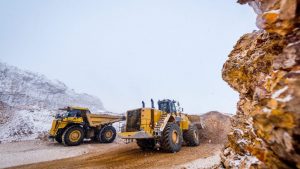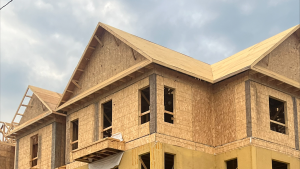Lock-Block Ltd. of Richmond, B.C. has developed the Arch-Lock, a pre-cast piece of concrete in a wedge shape that can be used to build arches and vaults without steel reinforcement.
Arch-Lock is based on the Roman arch, many examples of which are still standing.
Lock-Block founder and president Jay Drew says it can be used for highway and railroad underpasses and overpasses, tunnels, culverts and river crossings.
"Arch-Lock offers a modern approach to achieving the strength, beauty and durability of a Roman arch," says Drew, adding the arch, made of just stone and mortar, is "one of the strongest compression structures known to man."
"It has an immense load-carrying ability," he says. "And, because it contains no embedded steel, it has a longer service life."
Drew says structures that incorporate the Roman arch last for "hundreds and thousands of years.
"In comparison, bridges built of reinforced concrete last for approximate 85 years," he says. "Moisture enters cured concrete and rusts the rebar, which expands and causes pieces of concrete to flake off."
Arch-Lock is not entirely free of steel — it contains a small steel lifting hook.
"But the hook is at a 90-degree angle to the surface of the concrete block," says Drew. "So no water is able to enter the block and the concrete’s integrity is maintained."
In addition to its unusual wedge shape, Arch-Lock is notable for the manner in which the blocks are assembled to build an arch.
An Arch-Lock structure is assembled on what is called a zipper truck, a vehicle upon which sits a custom-built frame.
The zipper truck is lower at its rear than at its front. As the wedges are lifted onto the truck’s frame, the truck gradually moves forward.
As it does, the individual wedges gradually lock into place in much the same way that the teeth of a zipper interlock as the zipper is drawn up.
Drew says the zipper truck reduces the time it takes to build a tunnel or overpass by as much as 90 per cent.
"With it, one-and-a-half metres of an arch can be constructed every five minutes," he says. "Theoretically, you can build a quarter-mile-long archway in 24 hours and it will be immediately functional without a 28-day curing cycle. It’s the cheapest way to build highway overpasses."
Despite Drew’s enthusiasm, Arch-Lock’s only commercial application has been overpasses on a golf course in north-central B.C.
The obstacle in Lock-Block’s way is the need to prove scientifically that Arch-Lock can withstand earthquakes, a recognized threat on the West Coast.
To that end, Drew has been working with the University of British Columbia’s Earthquake Engineering Research Facility (EERF) to develop a testable computer model of what happens to an arch built with Arch-Lock during an earthquake.
"We test the arch on the facility’s shaking table, to see how it behaves during different types of earthquakes," says Martin Turek, the facility’s engineering manager. "We use those results to validate our models and then we can undertake detailed engineering studies."
Arch structures have a complex seismic behaviour, says Turek.
"The stability of an arch depends on keeping the line of forces between the faces of the blocks," he says. "During an earthquake, the force direction changes and hinges open between the blocks. When four of the hinges open, the structure collapses."
Turek says most of the research in the field focuses on the seismic behaviour of arches that were built long ago. Many have remained standing during an earthquake, but some have also collapsed.
"Many of the historic arches use mortar between the joints, which aids in their stability during an earthquake," Turek says.
"The system that Lock-Block is proposing is unique and focuses on longevity and ease of assembly. (But) concrete block arches are susceptible to large earthquakes and in certain cases additional reinforcement is required."
Turek says EERF is looking at ways to reinforce and stabilize an Arch-Lock structure that optimize seismic safety "while considering the cost and construction requirements to maintain the uniqueness of the system."
One of the solutions it is considering is an epoxy-carbon fibre sandwich that bonds to the concrete as it cures.
"It is a possible solution because it provides similar reinforcement to steel," Turek says. "It provides a tension load path in the case of an earthquake and also maintains the compression in the blocks."
Turek is confident they have come up with a solution that will work.
"We just need to work out all of the details," he says.

An Arch-Lock structure is assembled on what is called a zipper truck, a vehicle that has a custom-built frame. The zipper truck is lower at its rear than at its front. As the wedges are lifted onto the truck’s frame, the truck gradually moves forward. The wedges gradually lock into place in much the same way that the teeth of a zipper interlock.
Photo: Lock-Block Ltd."










Recent Comments
comments for this post are closed